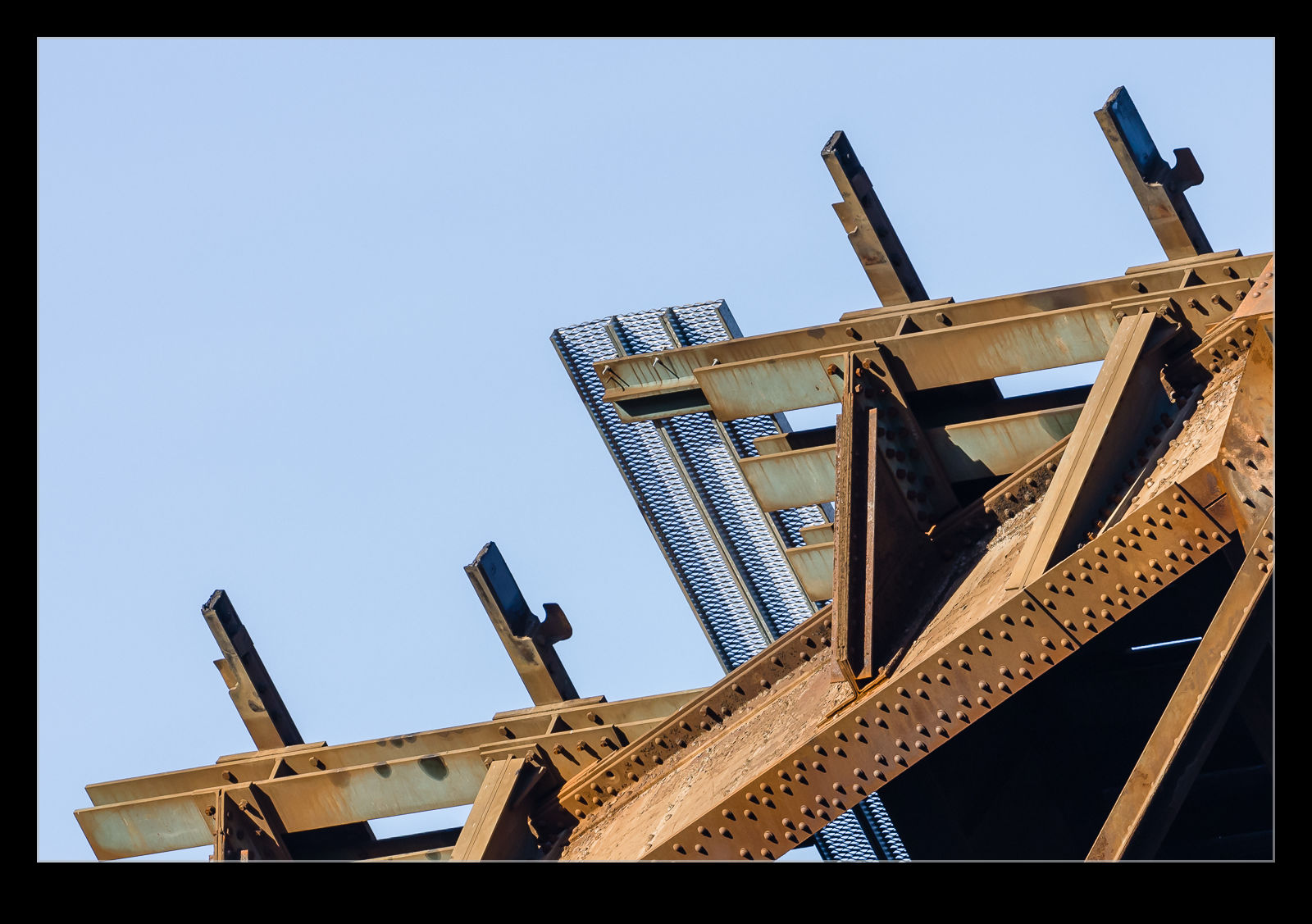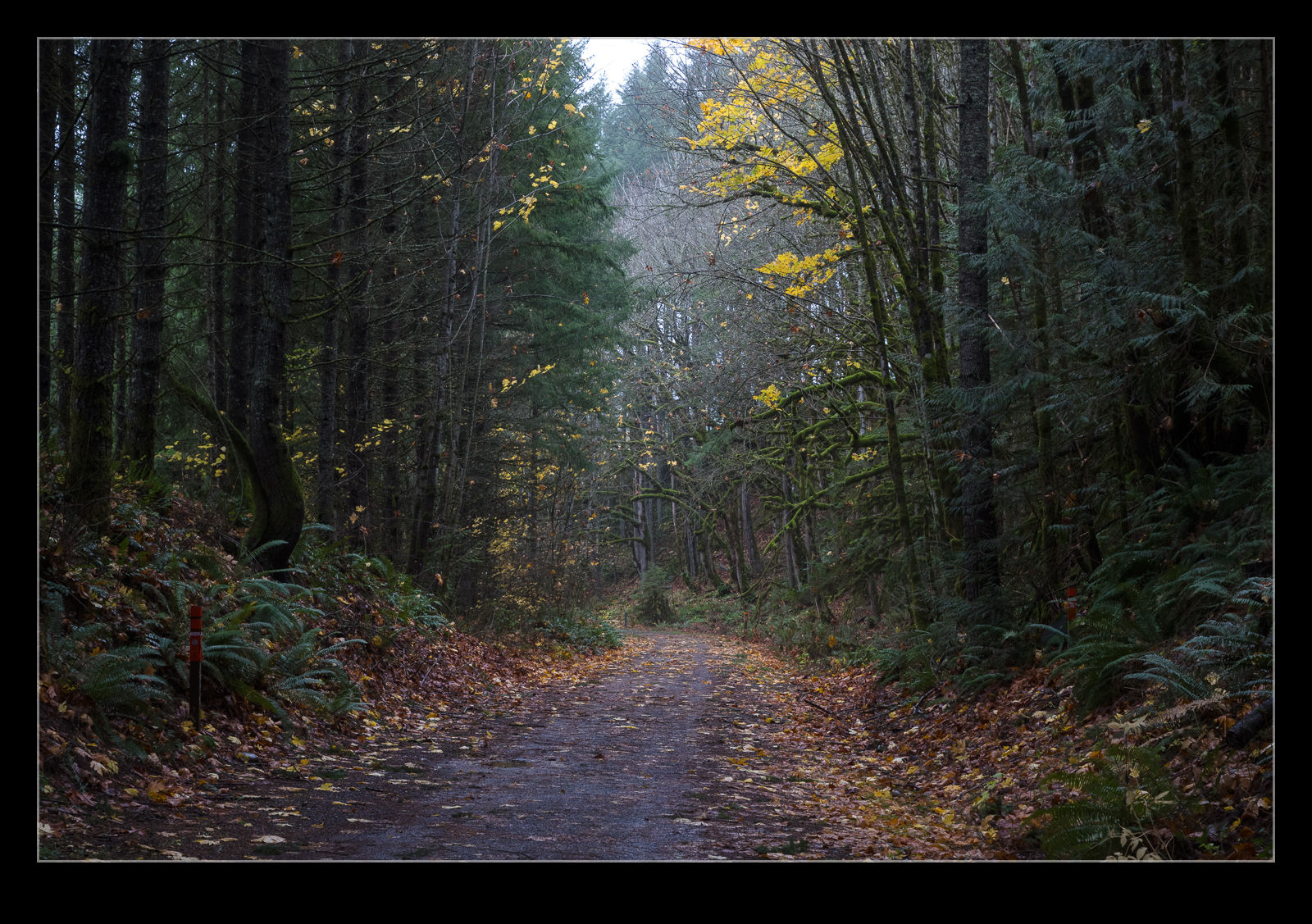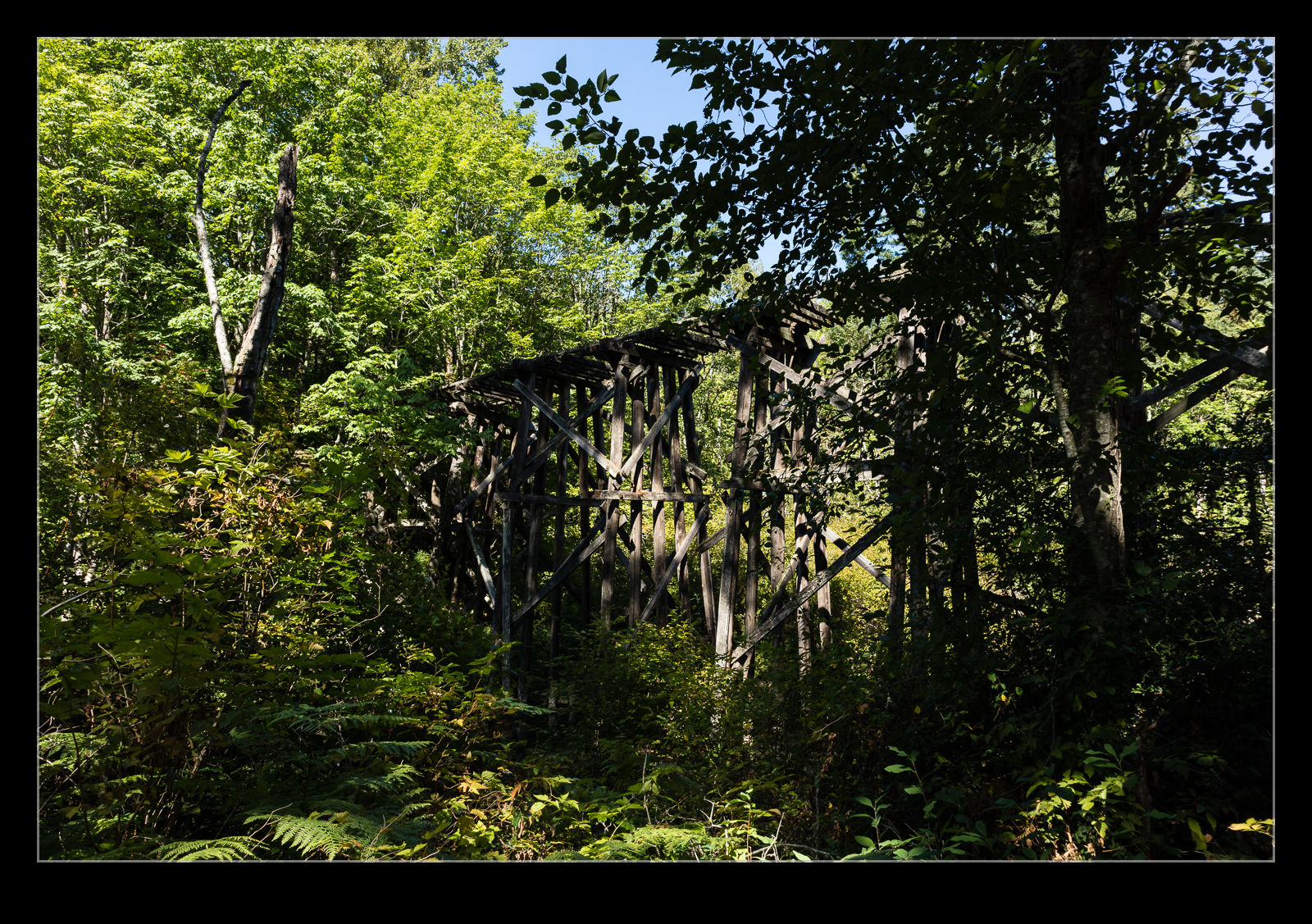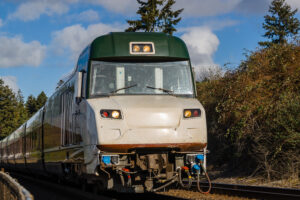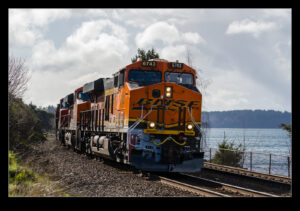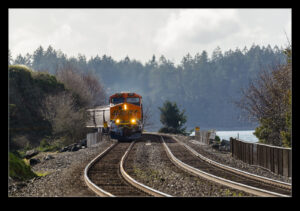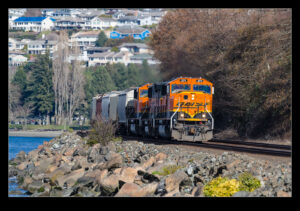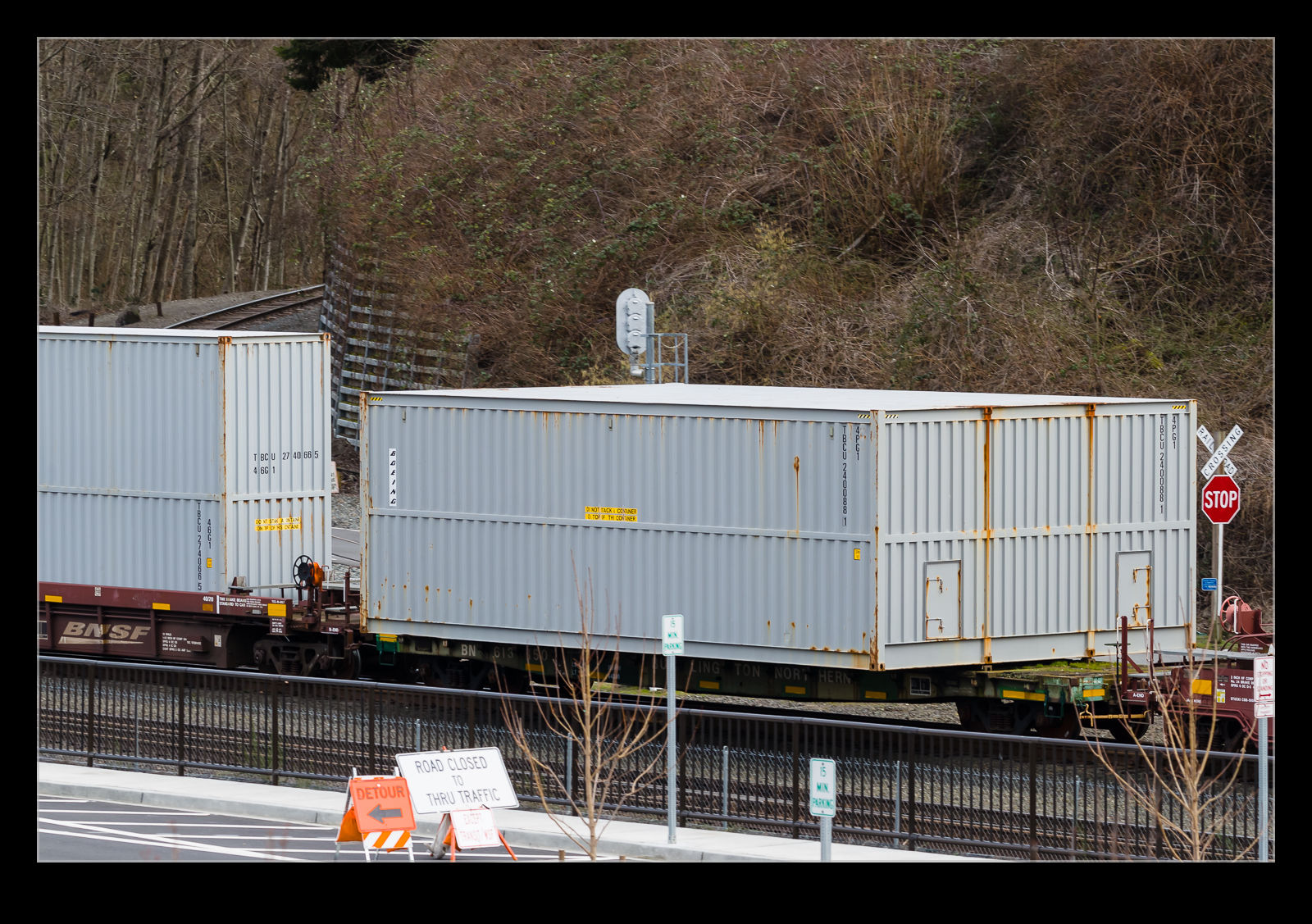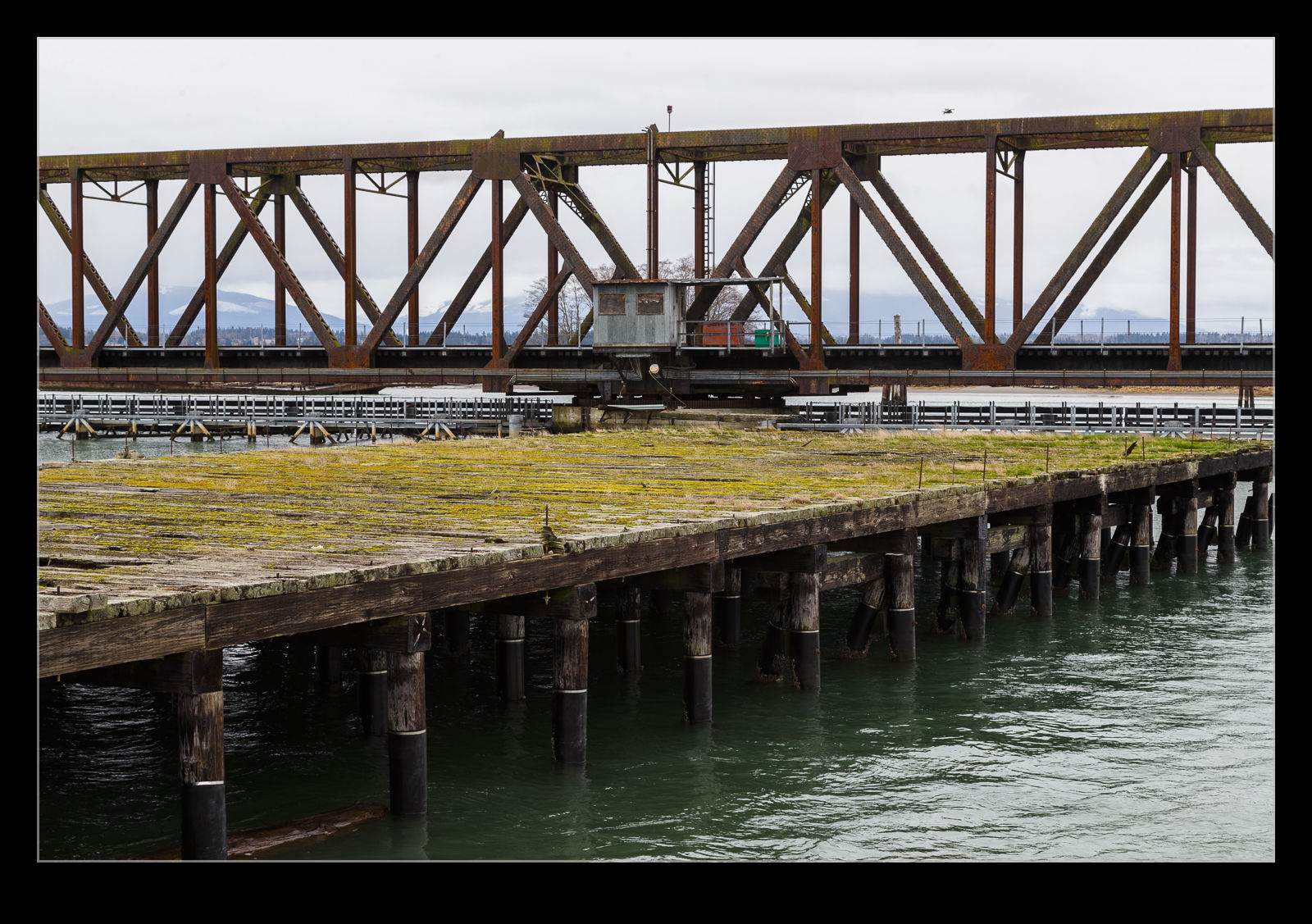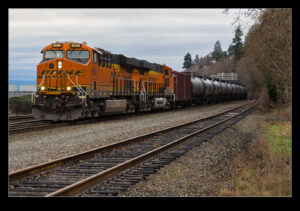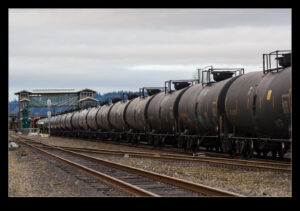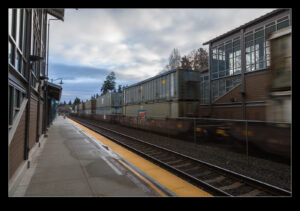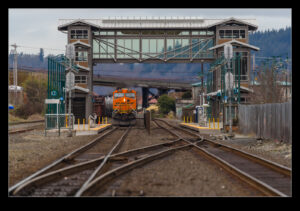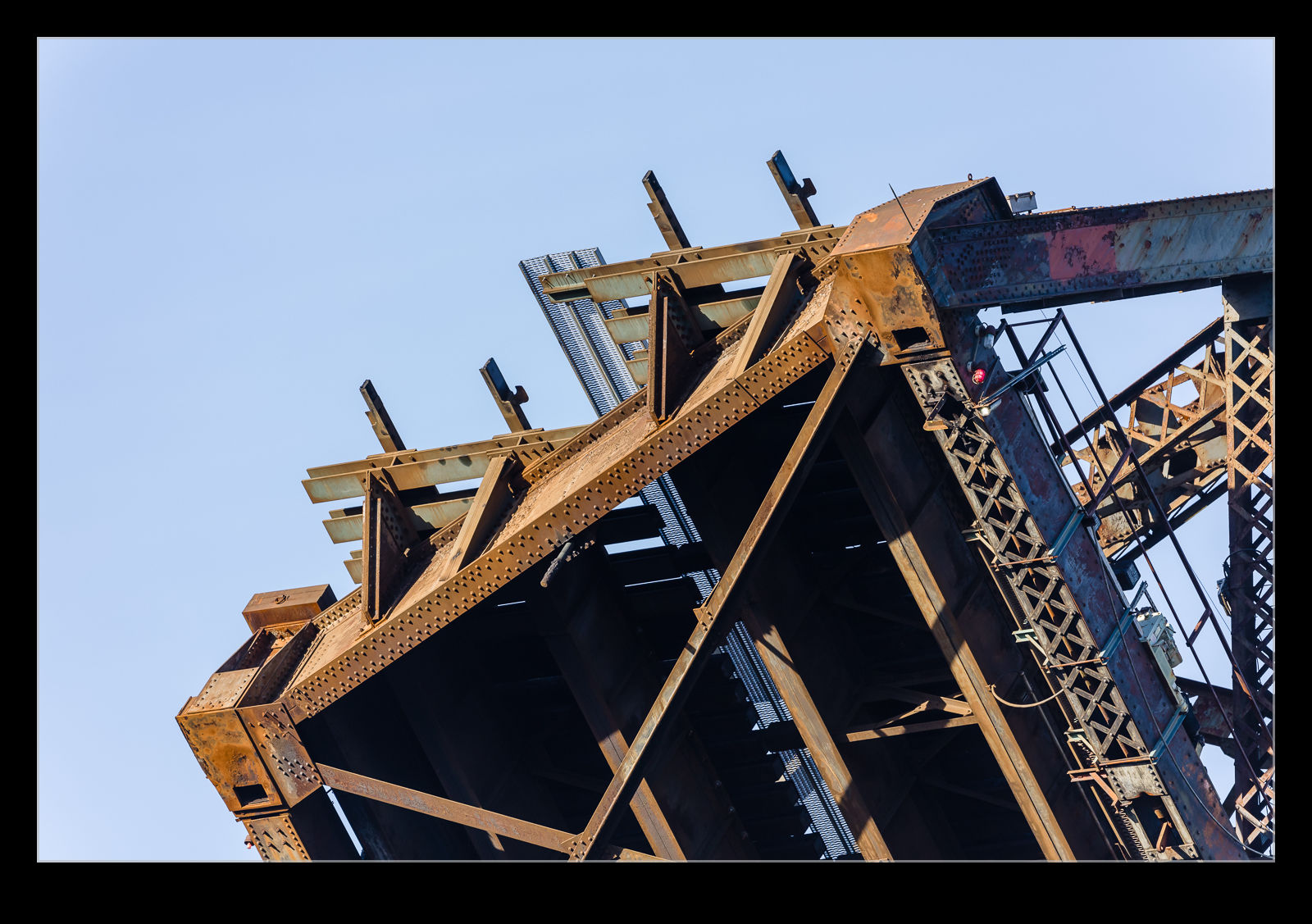 The railway that runs from Seattle up to Everett and either on to Vancouver or east across the Cascades crosses a bridge that is just outside the locks at Ballard. The bridge is a bascule bridge and, since there is quite regular boat traffic including sailing boats with high masts, it is frequently opened. The low winter light does a nice job of illuminating the underside of the deck of the bridge when it is open. I was more interested in the shapes at the end of the bridge where the rails end. They are clearly shaped to interlock with the opposite rails on the bridge approach and also to have a shape which allows the wheels to smoothly pass over without some sudden impact forces. As they stand up in the air, they strike me as rather fascinating.
The railway that runs from Seattle up to Everett and either on to Vancouver or east across the Cascades crosses a bridge that is just outside the locks at Ballard. The bridge is a bascule bridge and, since there is quite regular boat traffic including sailing boats with high masts, it is frequently opened. The low winter light does a nice job of illuminating the underside of the deck of the bridge when it is open. I was more interested in the shapes at the end of the bridge where the rails end. They are clearly shaped to interlock with the opposite rails on the bridge approach and also to have a shape which allows the wheels to smoothly pass over without some sudden impact forces. As they stand up in the air, they strike me as rather fascinating.
Tag Archives: railroad
Kenyan Locomotives
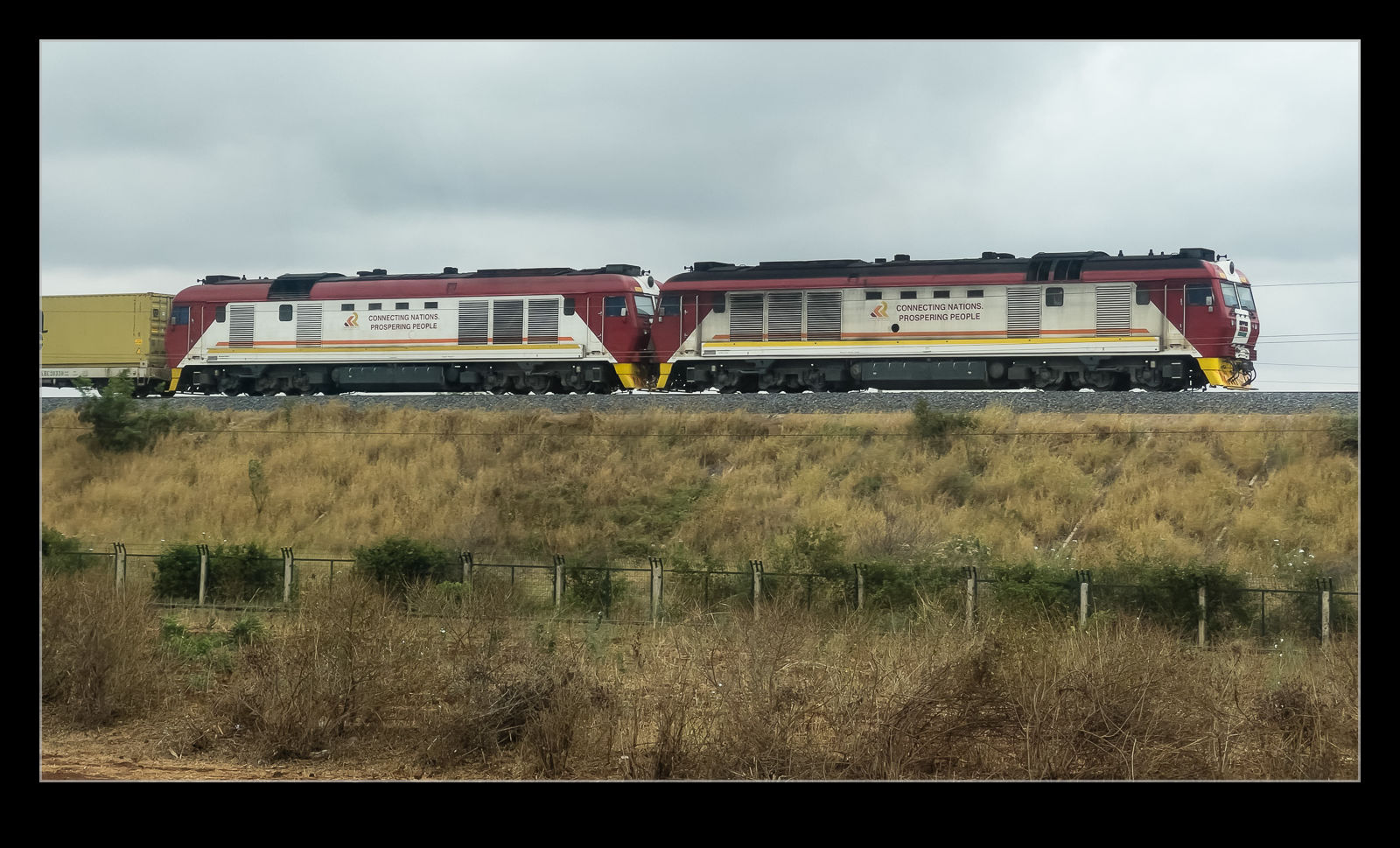 A combination of a travel image and the job stuff today. We were driving from Nairobi to Amboseli on our first full day in Kenya. The road we took initially is the main road to Mombasa which is the principal port for not only Kenya but some of its neighboring countries. Parallel with the road is a railway and, as we headed southeast, a train was coming the other way. A pair of diesel locomotives were pulling the train, and they had a message on the side about their role. I understand they were built by CRRC in China. One for the rail fans who read my blog, I think.
A combination of a travel image and the job stuff today. We were driving from Nairobi to Amboseli on our first full day in Kenya. The road we took initially is the main road to Mombasa which is the principal port for not only Kenya but some of its neighboring countries. Parallel with the road is a railway and, as we headed southeast, a train was coming the other way. A pair of diesel locomotives were pulling the train, and they had a message on the side about their role. I understand they were built by CRRC in China. One for the rail fans who read my blog, I think.
The Tehachapi Loop
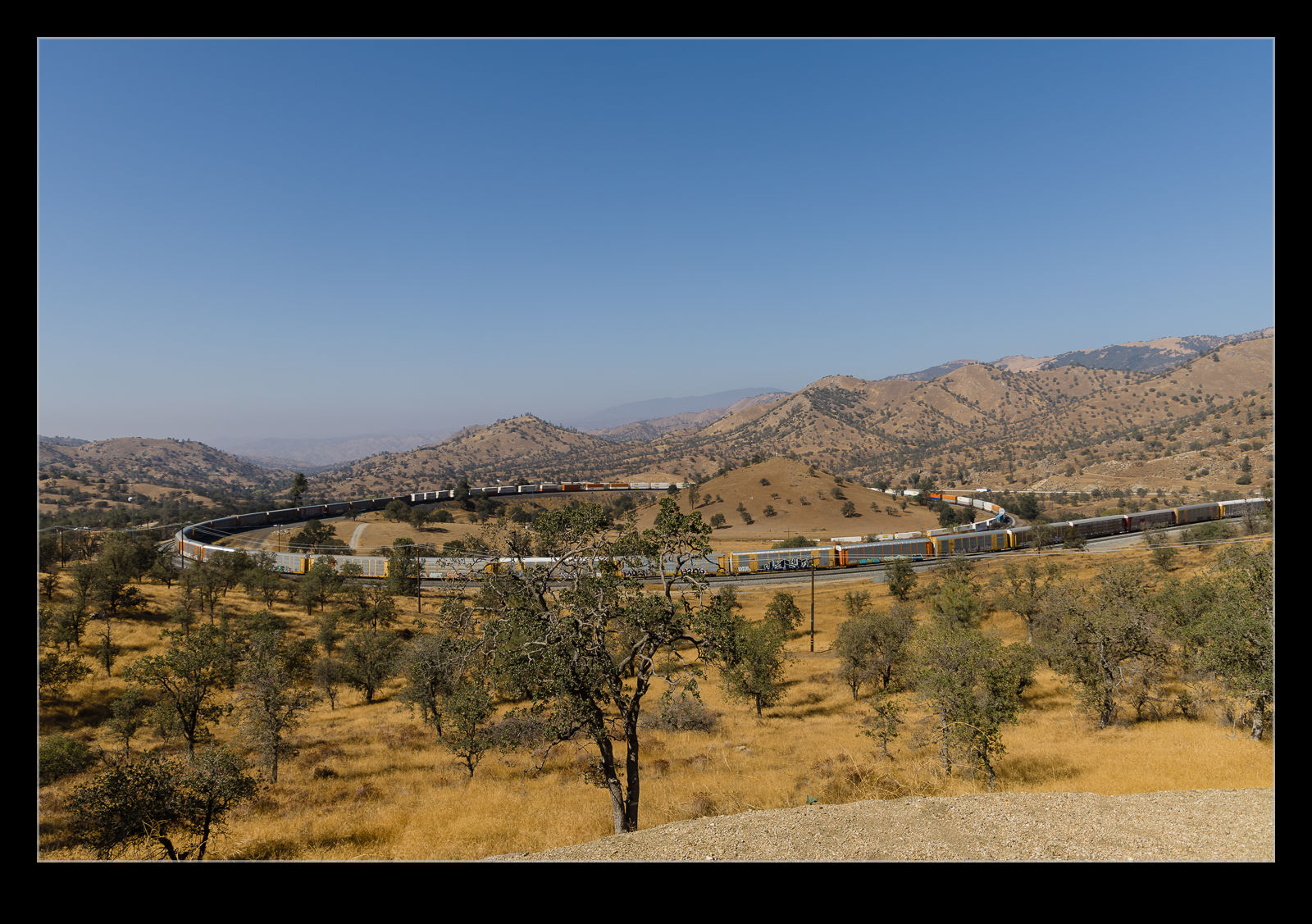 When I first started planning to trip to the Mojave Desert for the Edwards AFB show, a friend of mine in the Midwest was also planning on being there. He said he was also going to visit the Tehachapi Loop. I was vaguely aware of it but decided to look it up. While he ended up not making the trip, I took some time on my last day to go across to see the loop for myself. The Tehachapi Pass is a steep climb for a train to make and, in order for it to climb sufficiently in one section, the engineers that laid out the alignment put in a special configuration.
When I first started planning to trip to the Mojave Desert for the Edwards AFB show, a friend of mine in the Midwest was also planning on being there. He said he was also going to visit the Tehachapi Loop. I was vaguely aware of it but decided to look it up. While he ended up not making the trip, I took some time on my last day to go across to see the loop for myself. The Tehachapi Pass is a steep climb for a train to make and, in order for it to climb sufficiently in one section, the engineers that laid out the alignment put in a special configuration.
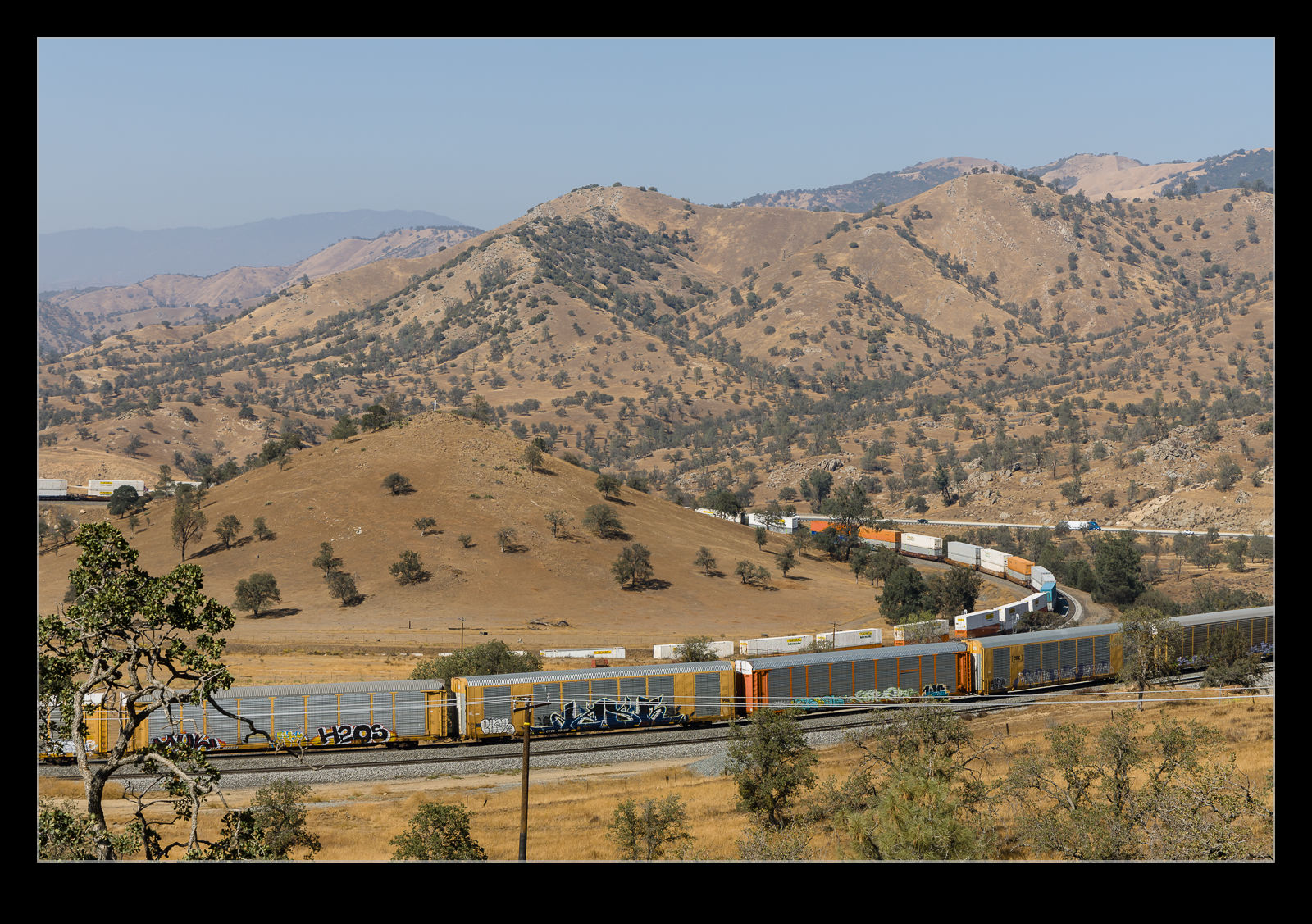 The trains make a 360 degree climbing turn and, given the length of the trains, the leading part of the train will pass over the top of the back end of the train as it climbs. It is quite something to have a long train twisting around on itself as it climbs the grade. Of course, descending is the reverse but that is less dramatic because the train is braking whereas the climbing trains are working flat out to make it up the hill. The sounds of the locomotives at high power reaches you long before they come in to sight.
The trains make a 360 degree climbing turn and, given the length of the trains, the leading part of the train will pass over the top of the back end of the train as it climbs. It is quite something to have a long train twisting around on itself as it climbs the grade. Of course, descending is the reverse but that is less dramatic because the train is braking whereas the climbing trains are working flat out to make it up the hill. The sounds of the locomotives at high power reaches you long before they come in to sight.
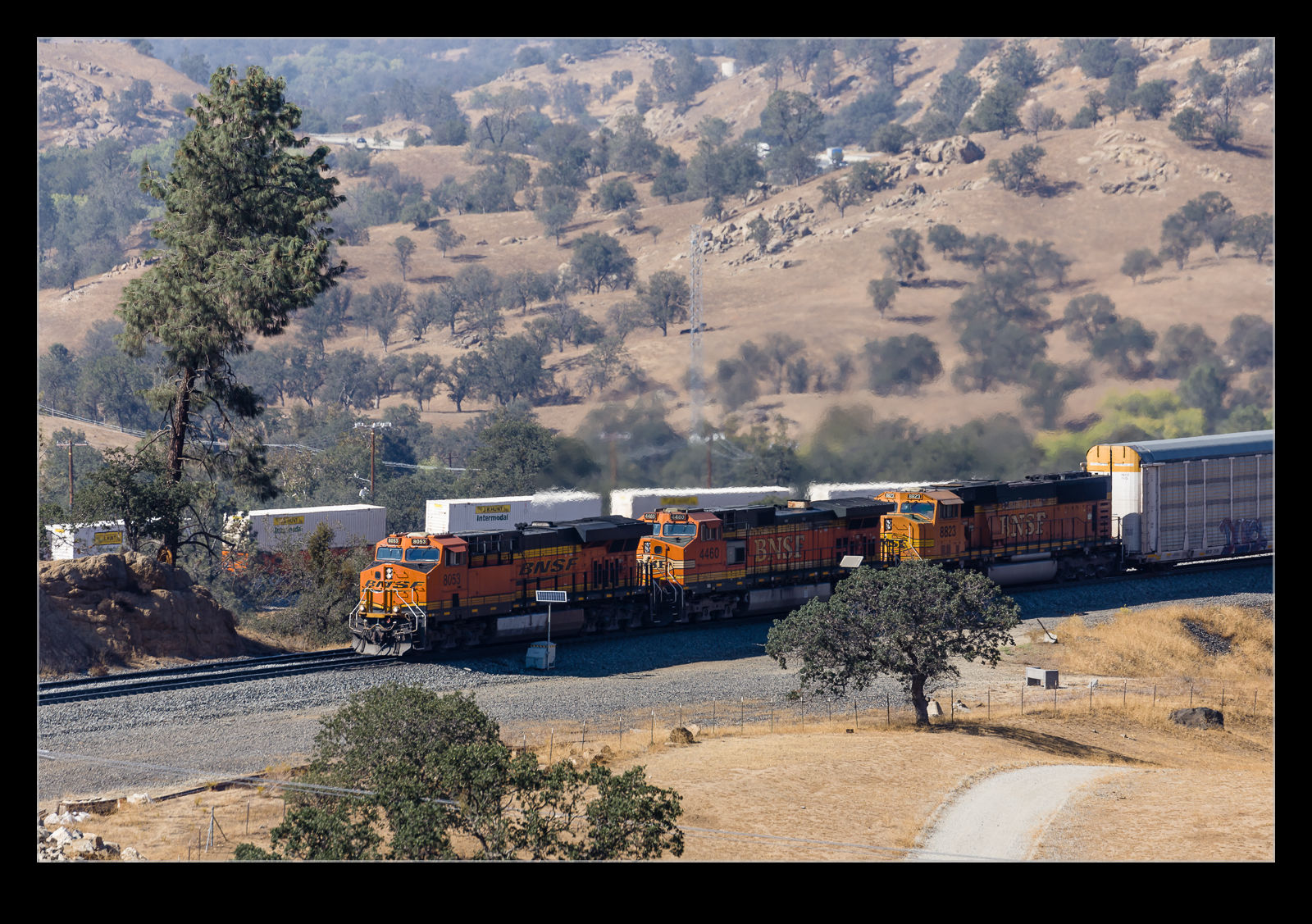 When I got there, I had no idea whether I would see a train or not. I had plenty of time but I didn’t know whether the trains were regular on a Sunday. Fortunately, it wasn’t long before a train came into the loop heading down the hill. I watched it negotiate the curves and the parts of the train appear and disappear. The interesting news was, as it got a little further down the hill, it stopped. This looked promising in that it was probably holding for a train coming up the other way. Sure enough, it wasn’t long before the sounds of multiple locos pulling hard came up the slope.
When I got there, I had no idea whether I would see a train or not. I had plenty of time but I didn’t know whether the trains were regular on a Sunday. Fortunately, it wasn’t long before a train came into the loop heading down the hill. I watched it negotiate the curves and the parts of the train appear and disappear. The interesting news was, as it got a little further down the hill, it stopped. This looked promising in that it was probably holding for a train coming up the other way. Sure enough, it wasn’t long before the sounds of multiple locos pulling hard came up the slope.
 There were four locos on the front of the train dragging their load towards the summit of the pass. The cars were stretched out behind them down the grade and, at the back (long after the lead locos had gone), another pair of locos were bringing up the rear. With the train safely by, I decided I wouldn’t hang around to see if there was more traffic. I had a drive back to the airport to do and didn’t need to wait around just in case.
There were four locos on the front of the train dragging their load towards the summit of the pass. The cars were stretched out behind them down the grade and, at the back (long after the lead locos had gone), another pair of locos were bringing up the rear. With the train safely by, I decided I wouldn’t hang around to see if there was more traffic. I had a drive back to the airport to do and didn’t need to wait around just in case.
Snoqualmie Valley Trail
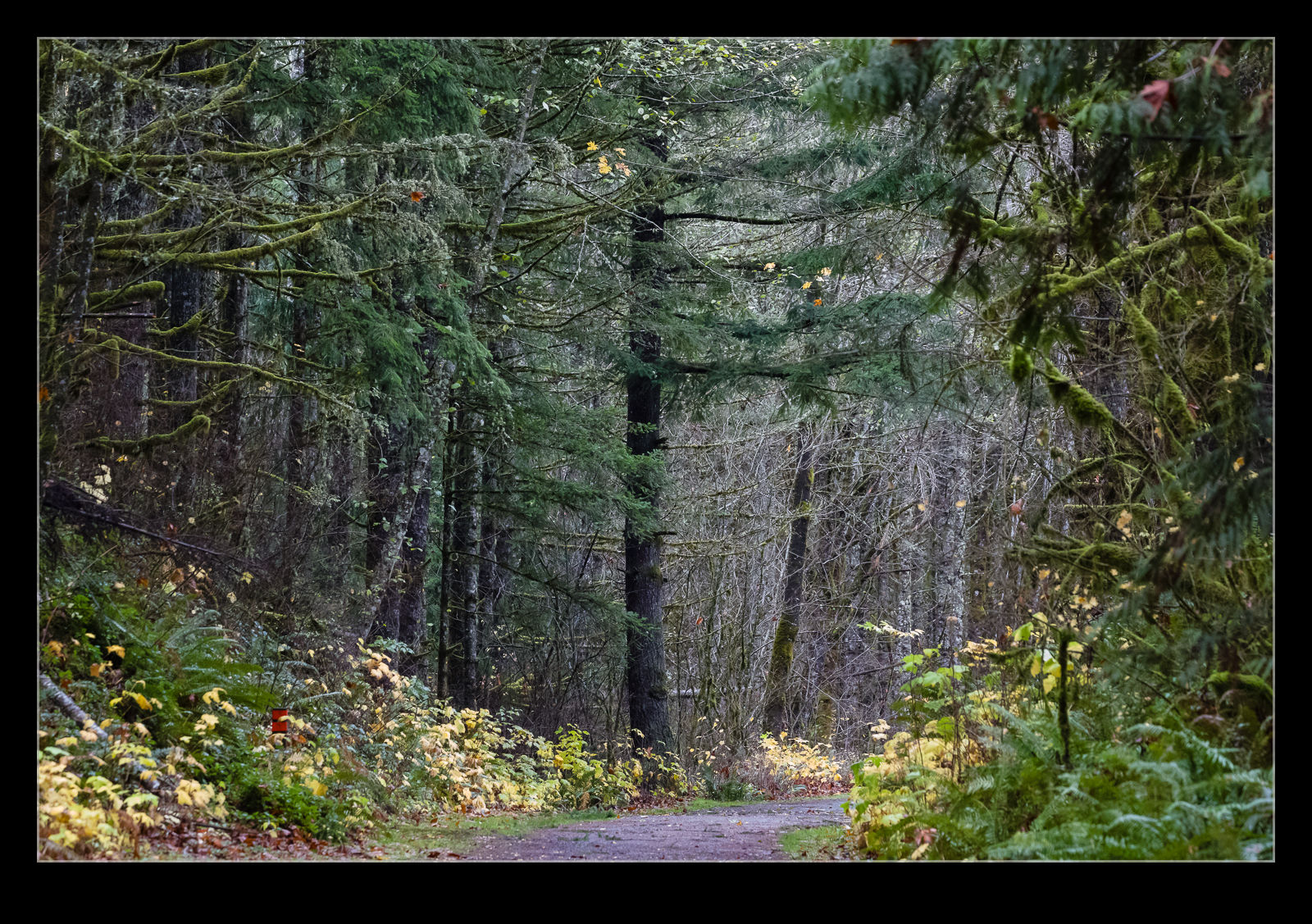 I can waste a fair bit of time panning around in Google Maps looking at things I had no idea were there. I was looking up near Snoqualmie Falls when I saw a label for Tokul Trestle. A look around showed a trail on the track bed of a disused railroad. The Snoqualmie Valley Trail starts down in the valley near Carnation and runs up to the town of Snoqualmie. I had no idea it was there and will be looking at riding it at some point. Anyway, I had a rainy Sunday and wanted to check out the falls – see another post specifically about that – and, having finished up there, I decided to take a walk along a section of the trail. It was intermittently raining but I was dressed appropriately so took a stroll. I did see the occasional cyclist, runner or walker but was on my own for most of the time. It did occur to me that the foothills of the Cascades have plenty of mountain lions but they were obviously elsewhere and left me alone.
I can waste a fair bit of time panning around in Google Maps looking at things I had no idea were there. I was looking up near Snoqualmie Falls when I saw a label for Tokul Trestle. A look around showed a trail on the track bed of a disused railroad. The Snoqualmie Valley Trail starts down in the valley near Carnation and runs up to the town of Snoqualmie. I had no idea it was there and will be looking at riding it at some point. Anyway, I had a rainy Sunday and wanted to check out the falls – see another post specifically about that – and, having finished up there, I decided to take a walk along a section of the trail. It was intermittently raining but I was dressed appropriately so took a stroll. I did see the occasional cyclist, runner or walker but was on my own for most of the time. It did occur to me that the foothills of the Cascades have plenty of mountain lions but they were obviously elsewhere and left me alone.
 The area is quite enclosed by the trees and it is clearly a damp place given the amount of lichen growing on the trees. That will also get another post. It does make for some interesting colors when the light does break through, though. The darkness of the trail contrasts nicely with the greens of the lichen as the sun catches it. Sections of it feel like you are walking through a tunnel. (There is an actual tunnel too but, you’ve guessed it, more of that another time.)
The area is quite enclosed by the trees and it is clearly a damp place given the amount of lichen growing on the trees. That will also get another post. It does make for some interesting colors when the light does break through, though. The darkness of the trail contrasts nicely with the greens of the lichen as the sun catches it. Sections of it feel like you are walking through a tunnel. (There is an actual tunnel too but, you’ve guessed it, more of that another time.)
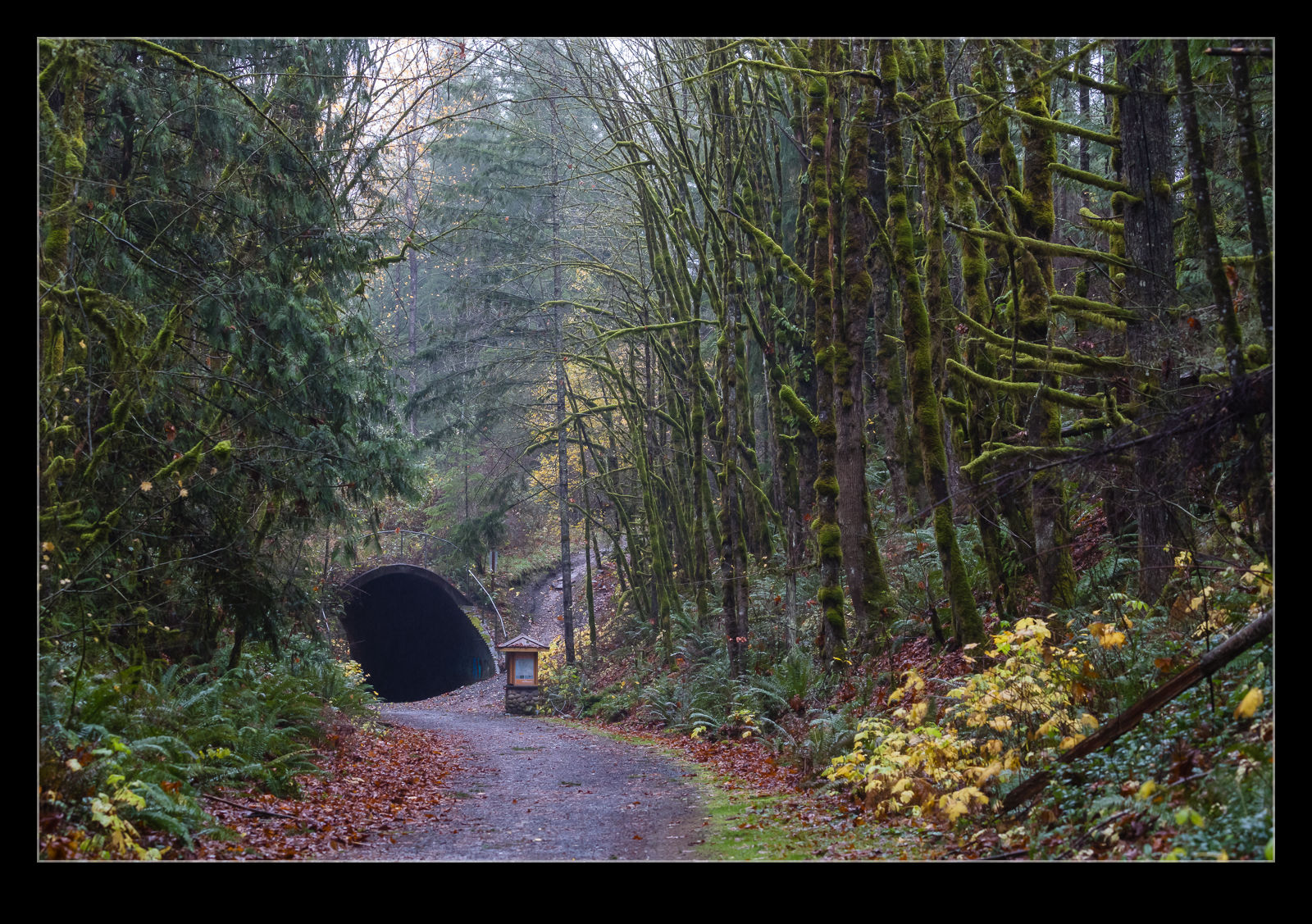 I look forward to getting to explore this trail in more detail. A bike seems like the best bet for checking it all out but there are a few trailheads along the way so driving up and walking along it will be a good option.
I look forward to getting to explore this trail in more detail. A bike seems like the best bet for checking it all out but there are a few trailheads along the way so driving up and walking along it will be a good option.
Old Trestle at Whatcom Falls
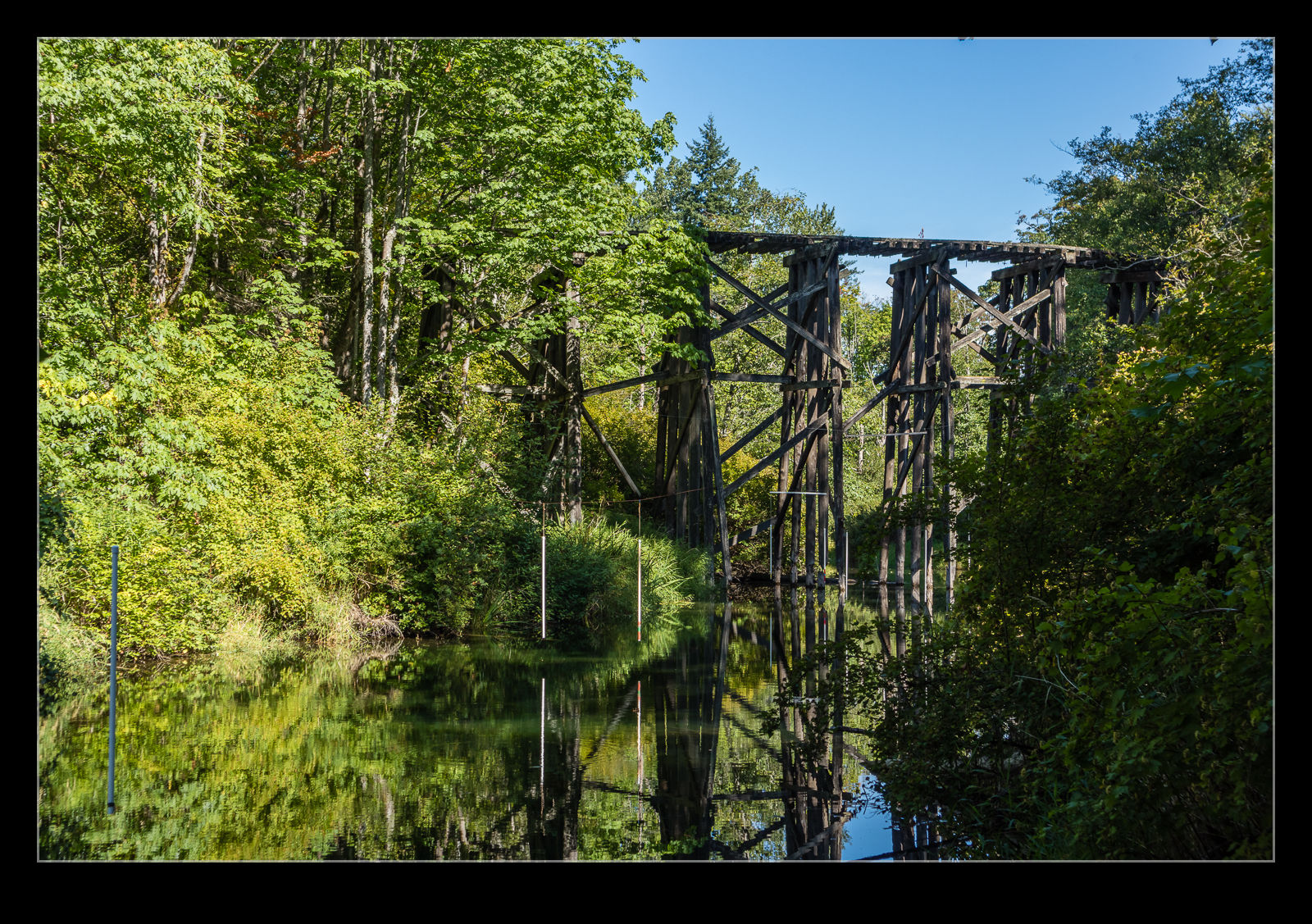 A railroad used to run through what is now Whatcom Falls Park. While the tracks have now gone, a trestle bridge across the water still remains. I may have lived in the US a long time now, the presence of trestle bridges still fascinates me. They have a look of Victorian railroads about them but many have survived. In the UK, old bridges are either iron or brick with multiple arches. The trestles have a distinctly American feel to them.
A railroad used to run through what is now Whatcom Falls Park. While the tracks have now gone, a trestle bridge across the water still remains. I may have lived in the US a long time now, the presence of trestle bridges still fascinates me. They have a look of Victorian railroads about them but many have survived. In the UK, old bridges are either iron or brick with multiple arches. The trestles have a distinctly American feel to them.
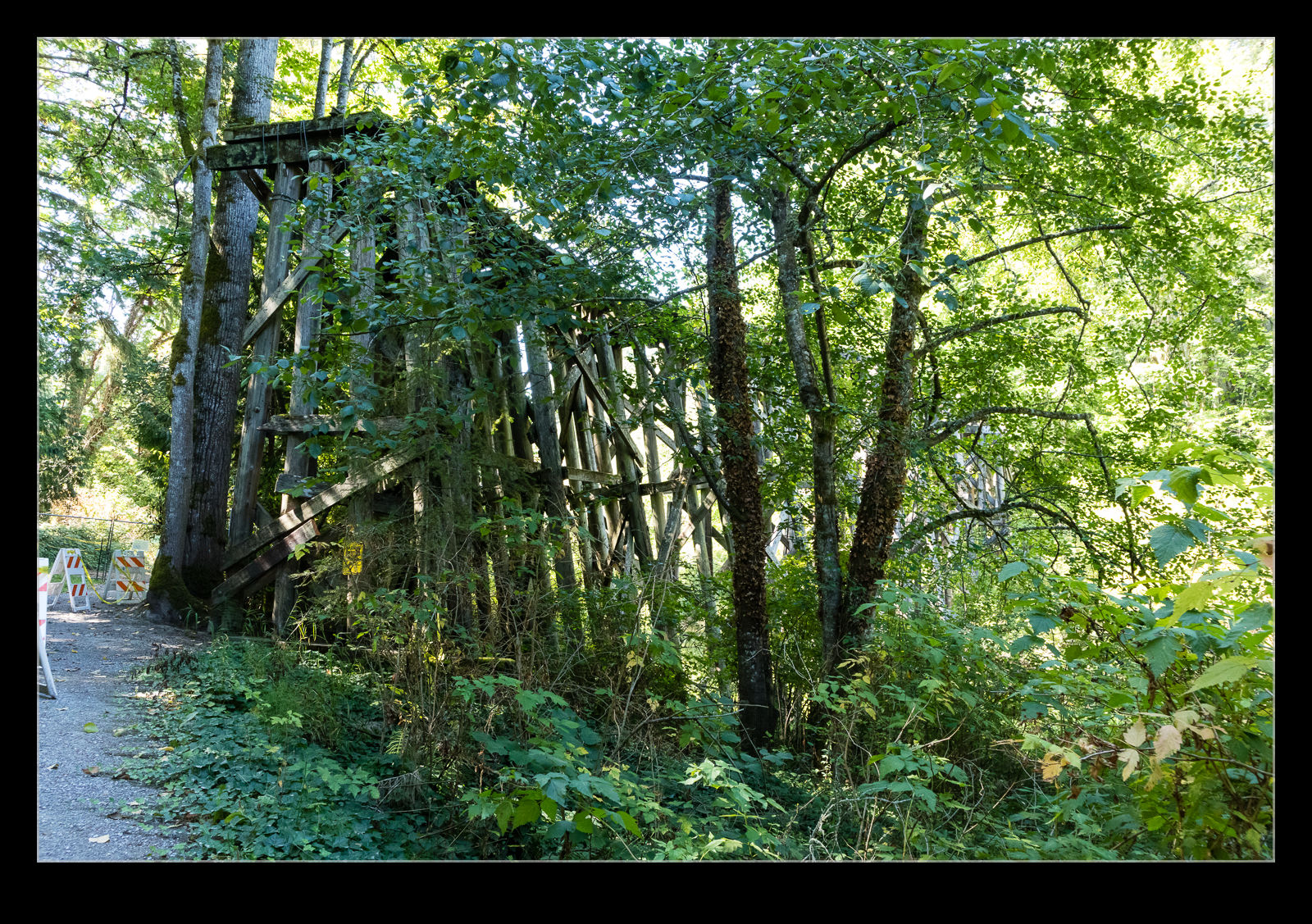 There were some barriers around the end of the bridge while we were there. Checking out some photos online, it looks like the rails used to be suspended across some of the space. Maybe these have been removed to stop people getting up there. Fortunately, the majority of the bridge is still intact. I wonder what happened to the track bed. The rails are visible up on the top with ties (sleepers) between them but no support which suggests. Train would have had a rough ride. There must have been more there at some point.
There were some barriers around the end of the bridge while we were there. Checking out some photos online, it looks like the rails used to be suspended across some of the space. Maybe these have been removed to stop people getting up there. Fortunately, the majority of the bridge is still intact. I wonder what happened to the track bed. The rails are visible up on the top with ties (sleepers) between them but no support which suggests. Train would have had a rough ride. There must have been more there at some point.
Mukilteo Rail Station
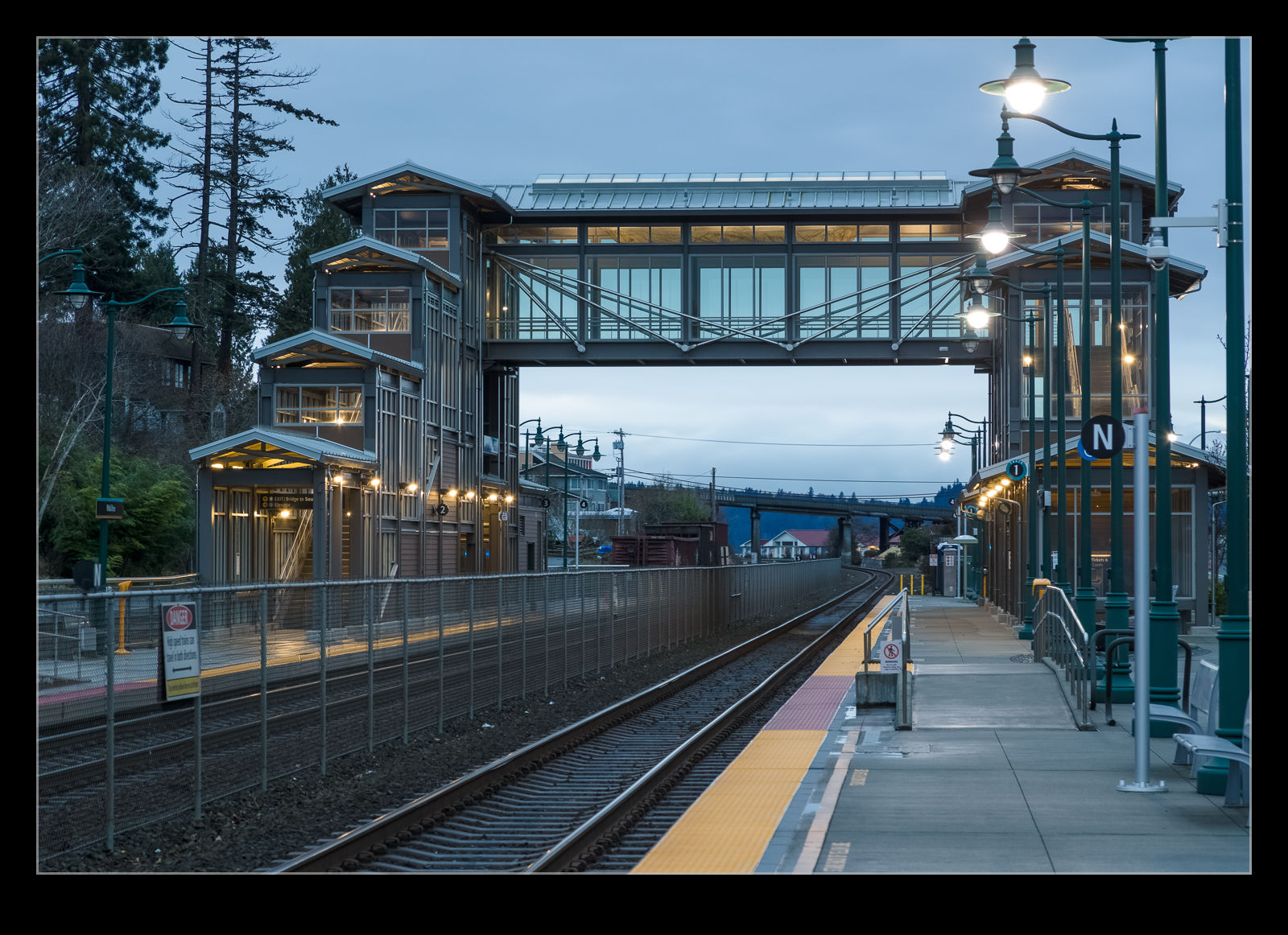 In all of my visits to the waterfront at Mukilteo, it would have been neglectful if I hadn’t had a quick poke around at the railroad station. This is for Sounder commuter rail trains to Seattle and is across from the new ferry terminal. It will be interesting to see whether WSDOT’s Amtrak Cascades trains stop there in the future to connect with the ferries but currently they do not (and, at the time of writing, the Cascades services north of Seattle are suspended anyway.)
In all of my visits to the waterfront at Mukilteo, it would have been neglectful if I hadn’t had a quick poke around at the railroad station. This is for Sounder commuter rail trains to Seattle and is across from the new ferry terminal. It will be interesting to see whether WSDOT’s Amtrak Cascades trains stop there in the future to connect with the ferries but currently they do not (and, at the time of writing, the Cascades services north of Seattle are suspended anyway.)
 The station is not that old since the Sounder service has only been around since the 2000s. Consequently, it is a nicely thought out design rather than an old station that has been upgraded. It includes some artwork with a local theme with stone sculptures of local boat designs. A footbridge takes you over the tracks to the far platforms. I doubt I will ever have the need to use it but it was fun to look around on a quiet weekend.
The station is not that old since the Sounder service has only been around since the 2000s. Consequently, it is a nicely thought out design rather than an old station that has been upgraded. It includes some artwork with a local theme with stone sculptures of local boat designs. A footbridge takes you over the tracks to the far platforms. I doubt I will ever have the need to use it but it was fun to look around on a quiet weekend.
Trains Through Steilacoom
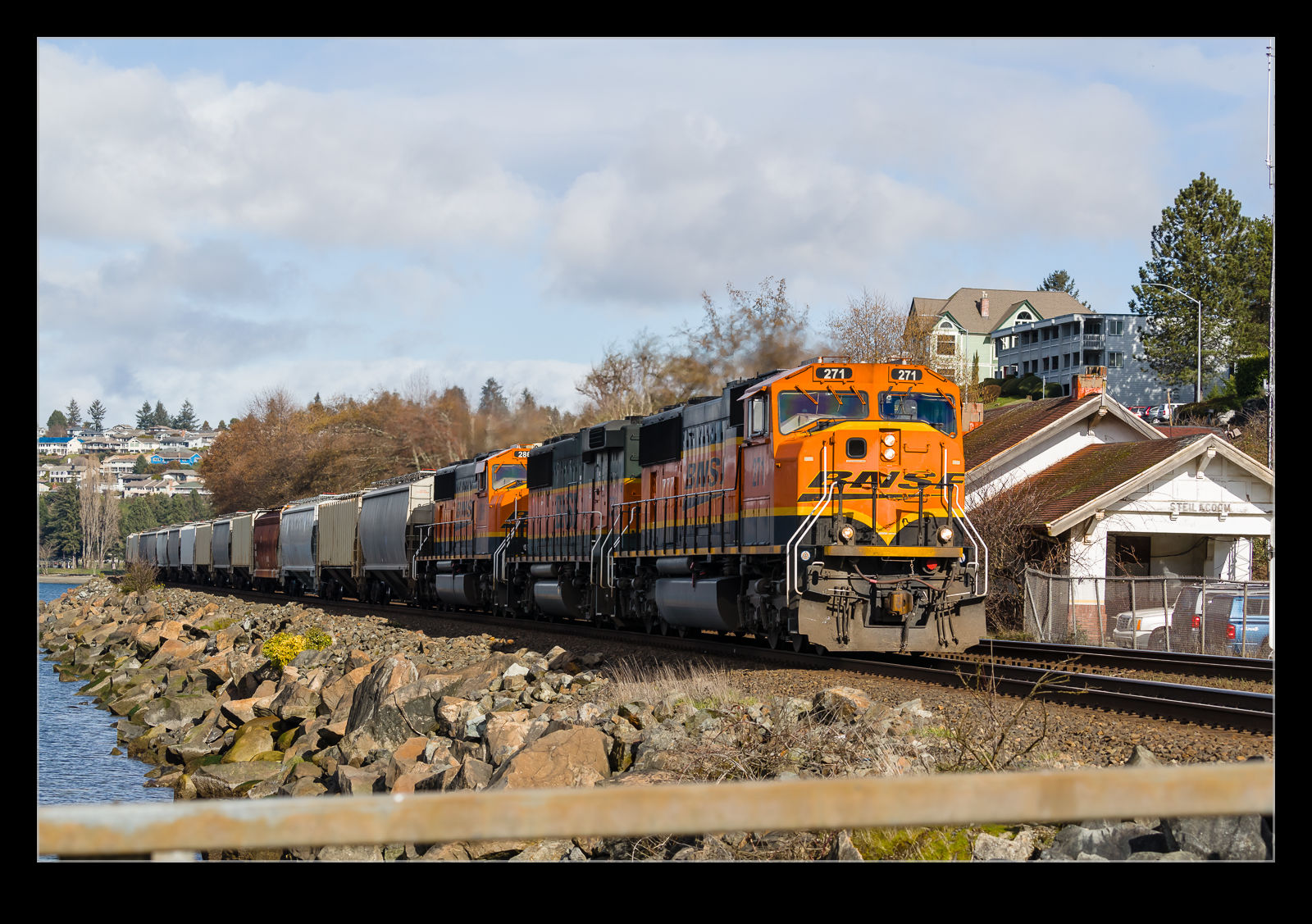 Another post for the rail fans out there. My visit to Steilacoom has yielded posts about the ferry and McNeil Island but it would be remiss to not discuss the rail line that runs along the waterfront. The weekend day I was there, there seemed to be a lot of traffic. This is the BNSF line along the coast but it is also currently used by Amtrak services. That was due to have stopped a while back with the Point Defiance Bypass having opened but, with an accident on the opening run, trains have continued to use the old route. That will transition at some point this year, though.
Another post for the rail fans out there. My visit to Steilacoom has yielded posts about the ferry and McNeil Island but it would be remiss to not discuss the rail line that runs along the waterfront. The weekend day I was there, there seemed to be a lot of traffic. This is the BNSF line along the coast but it is also currently used by Amtrak services. That was due to have stopped a while back with the Point Defiance Bypass having opened but, with an accident on the opening run, trains have continued to use the old route. That will transition at some point this year, though.
 A bunch of trains came through while I was there. Most of these were freight services but one was an Amtrak Cascades train. It was being operated with a Talgo Series 8 train owned by Oregon DOT and on which I have done a bunch of work over recent years. Since only one train is running per day in each direction as a result of the pandemic, it was a lucky coincidence that I was there when it came through. I did get a nice wave from the engineer.
A bunch of trains came through while I was there. Most of these were freight services but one was an Amtrak Cascades train. It was being operated with a Talgo Series 8 train owned by Oregon DOT and on which I have done a bunch of work over recent years. Since only one train is running per day in each direction as a result of the pandemic, it was a lucky coincidence that I was there when it came through. I did get a nice wave from the engineer.
The Widest Load I Have Seen
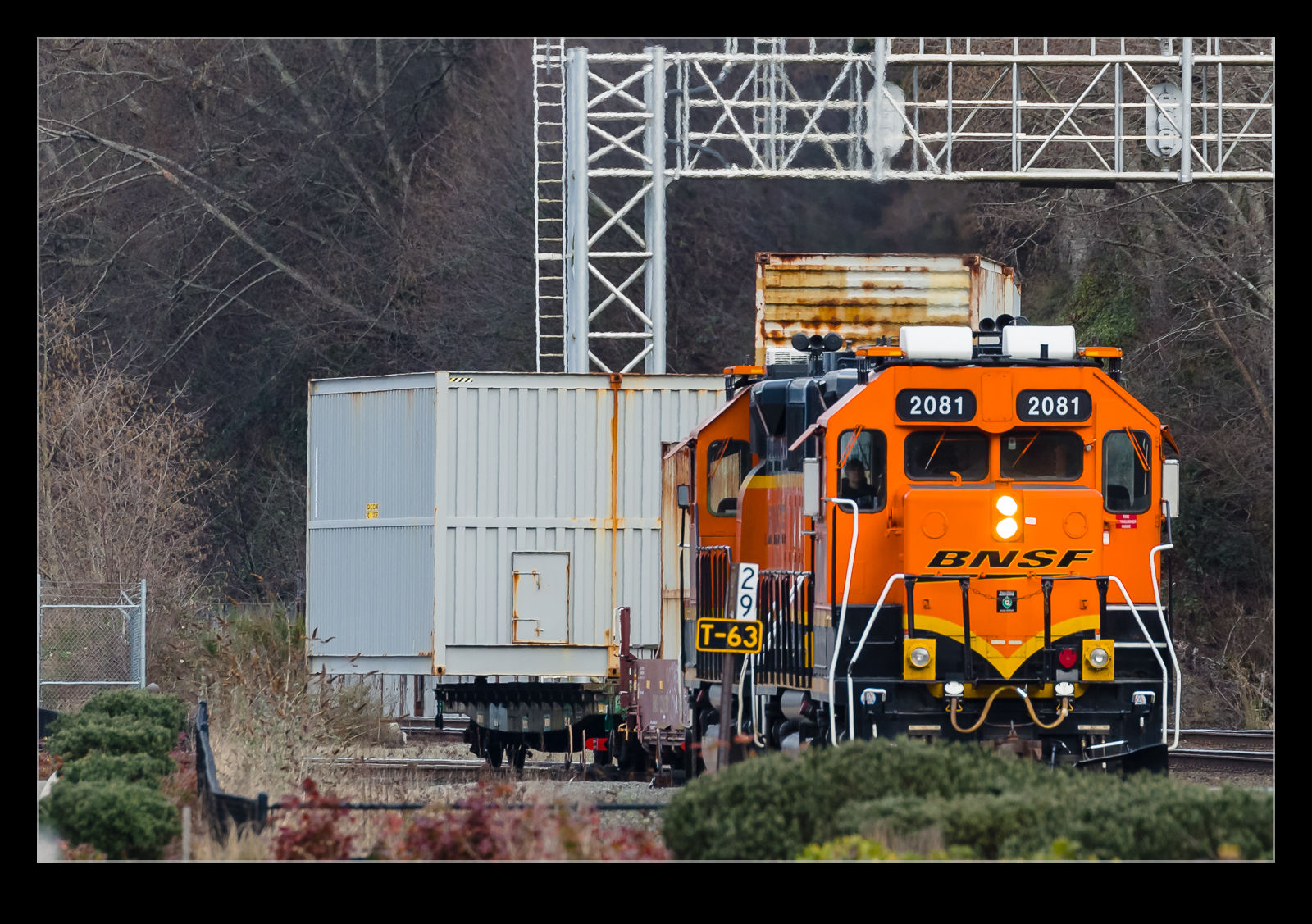 Railroads can be used to move unusual loads. In my work I have often had discussions about clearances along tracks to allow the Department of Defense to move outsized loads by rail – presumably tanks! However, most things I have seen have been within the normal clearance diagrams. As I was driving down to the waterfront park at Mukilteo, I passed a train sitting in a siding that was the widest thing I have ever seen on a train. It was two containers side by side. Both of them were hanging over the edge of the car. I assume that it was a single container for moving outsized loads and, given where it was staged, it might have been something to do with Boeing.
Railroads can be used to move unusual loads. In my work I have often had discussions about clearances along tracks to allow the Department of Defense to move outsized loads by rail – presumably tanks! However, most things I have seen have been within the normal clearance diagrams. As I was driving down to the waterfront park at Mukilteo, I passed a train sitting in a siding that was the widest thing I have ever seen on a train. It was two containers side by side. Both of them were hanging over the edge of the car. I assume that it was a single container for moving outsized loads and, given where it was staged, it might have been something to do with Boeing.
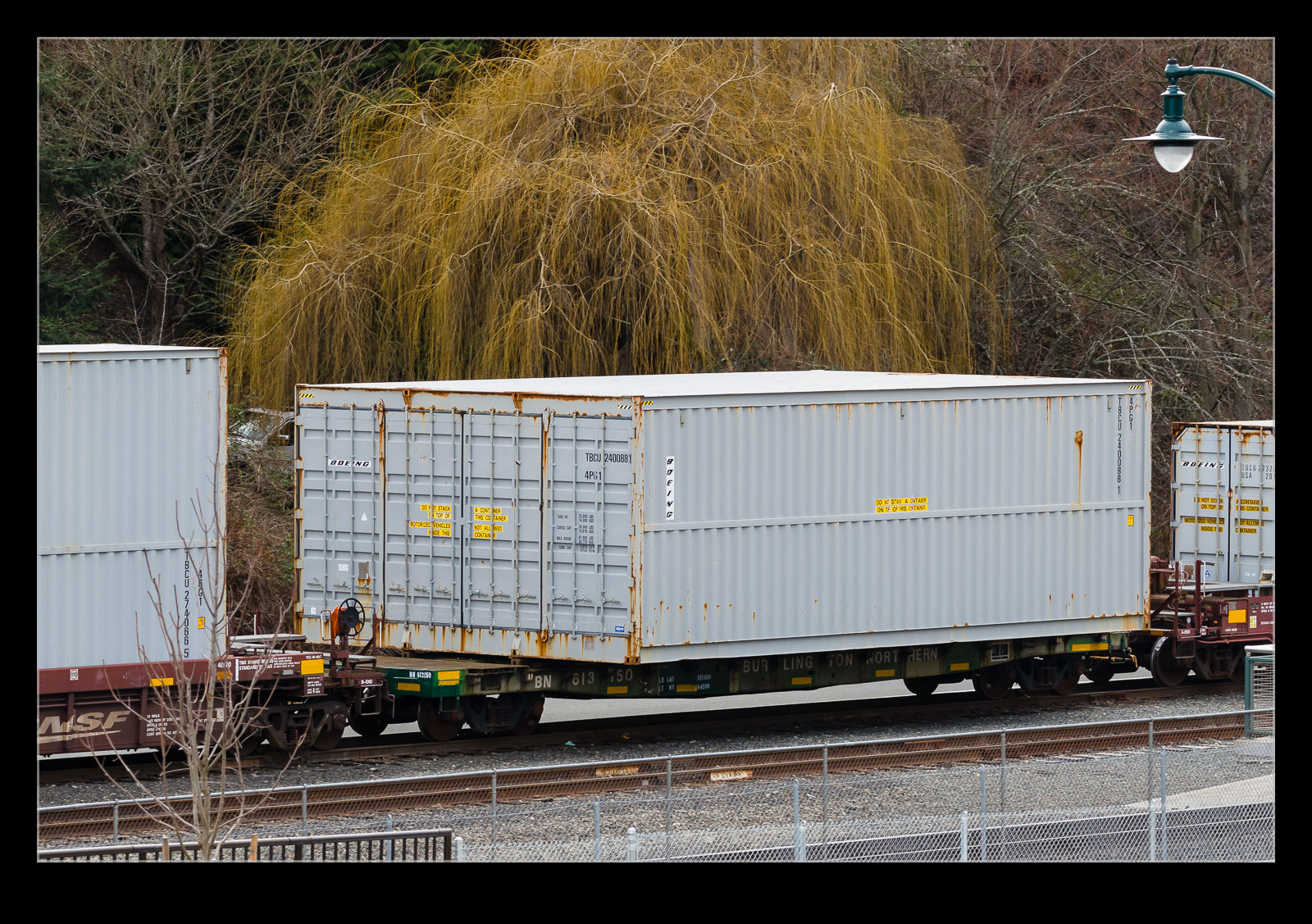 As I drove past it, I figured I would walk back and get a photo. However, some locomotives showed up and they started switching everything around. I didn’t get a chance to get a shot from close up. I did take some pictures from a distance and they then staged the vehicles out on the pier where Mukilteo becomes Everett. If anyone knows anything about this load, do let me know. I assume it needs special clearance to move since it must impinge on the adjacent tracks which would make passing other trains an issue!
As I drove past it, I figured I would walk back and get a photo. However, some locomotives showed up and they started switching everything around. I didn’t get a chance to get a shot from close up. I did take some pictures from a distance and they then staged the vehicles out on the pier where Mukilteo becomes Everett. If anyone knows anything about this load, do let me know. I assume it needs special clearance to move since it must impinge on the adjacent tracks which would make passing other trains an issue!
Railroad Swing Bridge Near Anacortes
 I was driving over the bridge heading towards Anacortes when I glanced down towards the casino near the water. I noticed a railroad swing bridge across the water which I hadn’t seen before. Since I was on my own and with no set schedule, I figured I would drop in and take a look. The railroad runs alongside the casino and crosses the river at an oblique angle. Consistently, the open position for the bridge is not perpendicular to the track but lies inline with the river.
I was driving over the bridge heading towards Anacortes when I glanced down towards the casino near the water. I noticed a railroad swing bridge across the water which I hadn’t seen before. Since I was on my own and with no set schedule, I figured I would drop in and take a look. The railroad runs alongside the casino and crosses the river at an oblique angle. Consistently, the open position for the bridge is not perpendicular to the track but lies inline with the river.
 Everything about the track looked in excellent condition so I assume the bridge is regularly used. I have seen plenty of trains on the track closer to Burlington but didn’t know they came this far. It would be interesting to see the bridge in use some time. It is a pretty long structure and the control house is on the opposite side of the river. A bald eagle was sitting on that side making a lot of noise but too far away to justify a photograph.
Everything about the track looked in excellent condition so I assume the bridge is regularly used. I have seen plenty of trains on the track closer to Burlington but didn’t know they came this far. It would be interesting to see the bridge in use some time. It is a pretty long structure and the control house is on the opposite side of the river. A bald eagle was sitting on that side making a lot of noise but too far away to justify a photograph.
BNSF Along The Puget Sound Shore
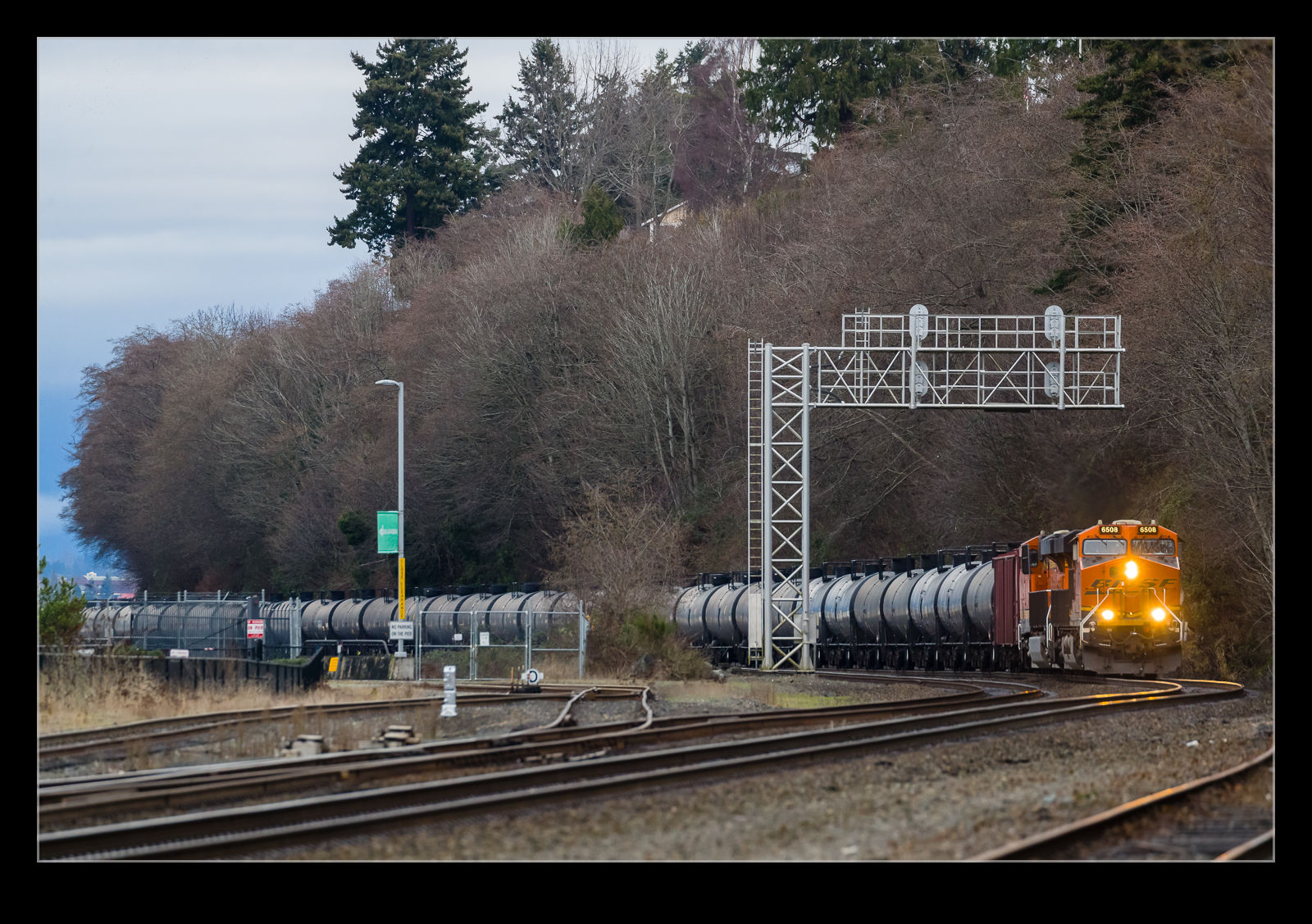 The terrain around Seattle is pretty undulating which is not ideal for railroads. Consequently, a good amount of the track is along the shoreline where you can be guaranteed to be flat (provided you do a little work). Mukilteo is part of the BNSF line and it runs between the houses on the hill and the water’s edge including the new ferry terminal. There is a station there too for the commuter trains Sound Transit runs.
The terrain around Seattle is pretty undulating which is not ideal for railroads. Consequently, a good amount of the track is along the shoreline where you can be guaranteed to be flat (provided you do a little work). Mukilteo is part of the BNSF line and it runs between the houses on the hill and the water’s edge including the new ferry terminal. There is a station there too for the commuter trains Sound Transit runs.
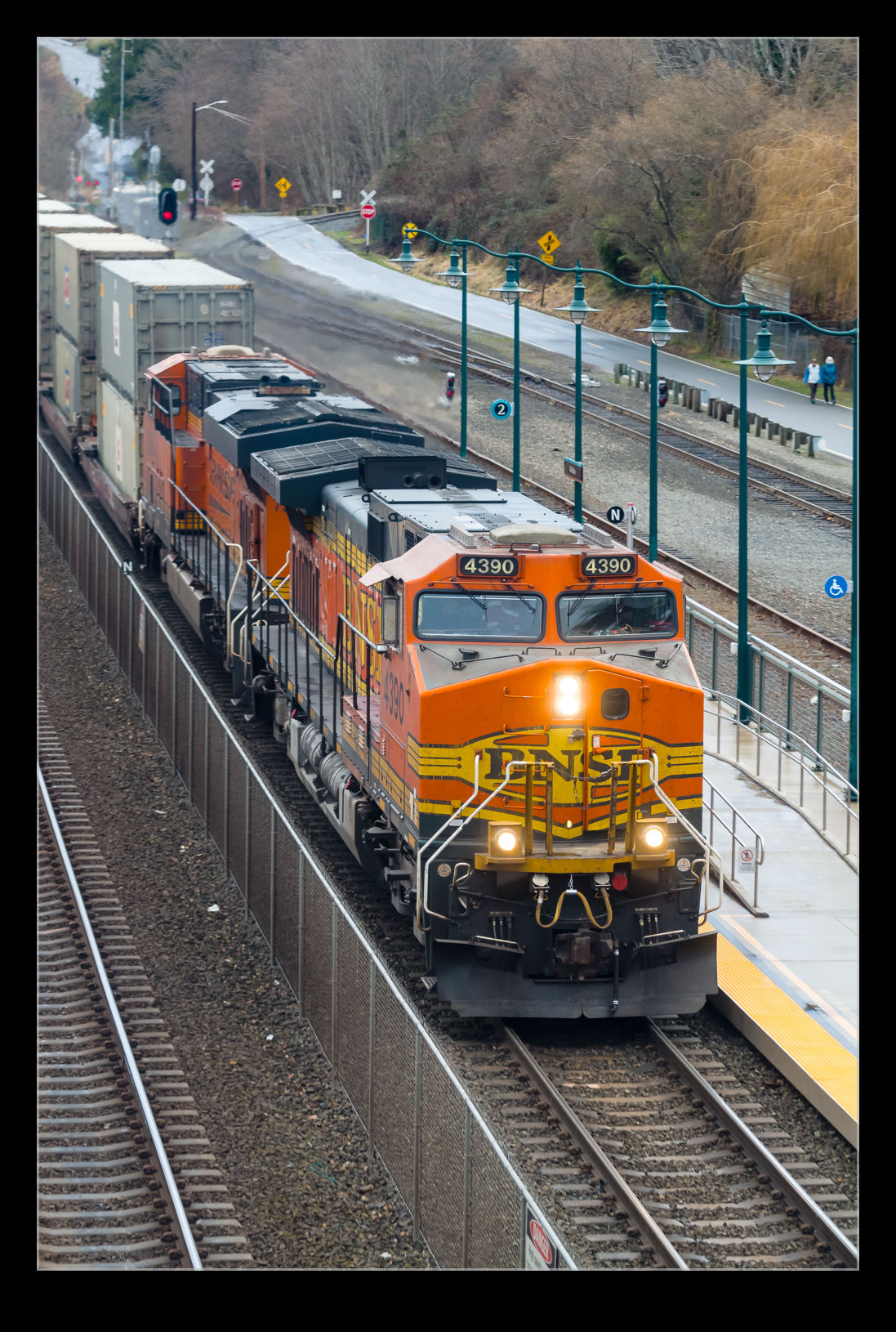 The majority of the traffic is freight traffic. Double stack containers or oil tank cars are a regular feature. I was there to look at the ferry traffic and the wildlife but, if a train is coming, I am not going to ignore it. One came through while I was in the station while another came through a little later when I was up at the grade crossing. For people living the US, long freight trains are not that unusual. For friends and family in the UK, the length of a US freight train can be quite a surprise. The leading locos can have disappeared off into the distance but the rear of the train hasn’t even come in to sight. A curving coastline like that along Puget Sound means it is easy to be unable to see each end.
The majority of the traffic is freight traffic. Double stack containers or oil tank cars are a regular feature. I was there to look at the ferry traffic and the wildlife but, if a train is coming, I am not going to ignore it. One came through while I was in the station while another came through a little later when I was up at the grade crossing. For people living the US, long freight trains are not that unusual. For friends and family in the UK, the length of a US freight train can be quite a surprise. The leading locos can have disappeared off into the distance but the rear of the train hasn’t even come in to sight. A curving coastline like that along Puget Sound means it is easy to be unable to see each end.
